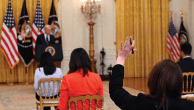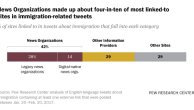When he took over the White House in January 2009, President Barack Obama quickly adopted much of the “faith-based initiative” put into place by his predecessor, President George W. Bush. The initiative was designed to expand the role of faith-based and community organizations in the delivery of social services.

But a new study by the Pew Research Center’s Project for Excellence in Journalism and the Pew Forum on Religion & Public Life finds that Obama’s faith-based initiative has so far generated little of the contentious press coverage associated with Bush’s effort. And the program is not as closely associated with the current president as it was with the man he succeeded.
The new study examines newspaper coverage of the faith-based initiative during the first six months of the Obama and Bush administrations and finds that the topic received nearly seven times more coverage in the first six months of 2001 than it did during the same period in 2009.
[1]
But when Obama established his own faith-based initiative, the press coverage focused primarily on procedural matters – including the renaming of the office as the White House Office of Faith-Based and Neighborhood Partnerships; its new director, Joshua DuBois; and a new, 25-member faith-based advisory council – as well as questions about how Obama would address issues that arose during the eight years of Bush’s faith-based initiative. The one controversy that generated a relatively significant amount of coverage in the first six months of the Obama administration concerned whether faith-based groups that receive federal funds should be able to consider a potential employee’s religion when making hiring decisions.
[2]
Also among the findings:
- Coverage of the faith-based initiative was almost 50% more likely to be on the front page of newspapers in 2001 than in 2009. In the first half of 2001, 15% of the stories—43 stories in total—appeared on the front page. In the first half of 2009, that number dropped to 10%, or only five stories.
- Issues related to the separation of church and state were the top concern in the press in 2001. Fully 40% of the newspaper coverage focused on whether the initiative violated this constitutional line. In 2009, the top controversy in the coverage analyzed was the unresolved faith-based hiring issue. More than a third of the stories (36%) dealt with this debate.
- In each year studied, Christianity was referenced nearly as often as Judaism and Islam combined. In total, the Christian faith was directly referenced in 32% of the stories. This was followed by references to Judaism and Islam, at 21% and 15%, respectively.
- In both years, newspaper coverage of the faith-based initiative was often a Washington-focused story. Of all the articles analyzed, 56% carried Washington, D.C., datelines, while no other single city came close.
Footnotes 1. “God’s place on the dais,” Bill Broadway, The Washington Post, Jan. 27, 2001 2. The following newspapers were used in the analysis: Arkansas Democrat-Gazette, The Boston Globe, Chicago Tribune, Los Angeles Times, Minneapolis Star Tribune, The New York Times, USA Today and The Washington Post.




